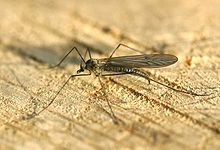Trichoceridae
| Winter crane flies Temporal range:
| |
|---|---|

| |
| Trichocera hiemalis | |
| Scientific classification | |
| Domain: | Eukaryota |
| Kingdom: | Animalia |
| Phylum: | Arthropoda |
| Class: | Insecta |
| Order: | Diptera |
| Suborder: | Nematocera |
| Infraorder: | Tipulomorpha |
| Superfamily: | Trichoceroidea |
| Family: | Trichoceridae Rondani, 1841 |
| Genera | |
| |
Trichoceridae, or winter crane flies, of the order Diptera are long, thin, delicate insects superficially similar in appearance to the Tipulidae, Tanyderidae, and Ptychopteridae. The presence of ocelli distinguishes the Trichoceridae from these other families. There are approximately 160 known species. The adults can be found flying in the fall and the spring and some are active even in the winter, hence their common name. They form dancing, loose swarms of mostly males. Adults can also be found resting inside caves and hollow logs. Larvae occur in moist habitats where they feed on decaying organic matter. They are important contributors to winter food webs.
Range
Distributed globally. Most Trichoceridae species are found in non-tropical regions (Holarctic regions). There are 27 species in North America.
Description
Besides Trichoceridae, there are very few insects that appear in adult form during winter months. They are usually seen in the fall or early spring and can be seen on mild winter days. Adult trichocerids are medium-sized flies that are hard to distinguish in the field. Aside from the presence of ocelli, they have a V-shaped suture on the mesonotum and distinct wing venation (if present). Larvae are also found in colder months throughout the year. They live in decaying vegetable matter and can be distinguished by their well-developed head capsule, amphineustic spiracular arrangement, and are oblique/vertical.
Evolutionary history
The oldest fossil of the group is Mailotrichocera, which is known from the Early to Late Jurassic of Eurasia.[1]
References
- ^ Lukashevich, Elena D.; Ribeiro, Guilherme C. (2019-04-18). "Mesozoic fossils and the phylogeny of Tipulomorpha (Insecta: Diptera)". Journal of Systematic Palaeontology. 17 (8): 635–652. doi:10.1080/14772019.2018.1448899. ISSN 1477-2019.
Further reading
- Borror, D.J., C.A. Triplehorn, & N.A. Johnson. 1989. An Introduction to the Study of Insects, Sixth edition. Saunders College Publishing.
- Krzemińska, E. 1991. Trichoceridae. Checklist of Animals of Poland. Vol. II. J. Razowski, ed. Wrocław-Warszawa-Kraków. Ossolineum, Polish Academy of Sciences.
- Krzemińska, E. 1995. Trichoceridae. Checklist delle specie della fauna Italiana. Vol. 62-65. Pp. 17–39. Edizioni Calderini.
- Krzemińska, E. 1996. Trichoceridae. Brand-Stof. Een inventarisatie van der entomofauna van het Natuurreservaat "De Brand" in 1990. J. W. A. van Zuijlen, T. M. J. Peeters, P. S. van Wielink, A. P. W. van Eck, & E. H. M. Bouvy, eds. Insektenwerkgroep KNNV-afdeling Tillburg. Pp. 97–98.
- Pratt, H.D. 2003. The winter crane flies of North America north of Mexico (Diptera: Trichoceridae). Proceedings of the Entomological Society of Washington, 105: 901–914.
- Triplehorn, Charles A., Norman Johnson F., and Donald Borror J. Borror and DeLong's Introduction to the Study of Insects. 7th ed. Belmont, CA: Thompson Brooks/Cole, 2005.
- Petrašiūnas, Andrius, and Gunnar Kvifte Mikalsen. "New Records of Trichoceridae (Diptera) from the Island of Mallorca." Biodiversity Data Journal, Vol. 4, Issue 4. 21 Jan. 2016.
- “The oldest Polyneura (Diptera) and their importance to the phylogeny of the group,” Wieslaw Krzeminski 1991.
External links
- Bishop Museum Fossil Insect Catalog
- Family Trichoceridae at Bishop Museum
- Photograph of adult
- Images from BugGuide